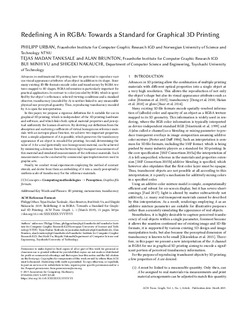| dc.description.abstract | Advances in multimaterial 3D printing have the potential to reproduce various visual appearance attributes of an object in addition to its shape. Since many existing 3D file formats encode color and translucency by RGBA textures mapped to 3D shapes, RGBA information is particularly important for practical applications. In contrast to color (encoded by RGB), which is specified by the object’s reflectance, selected viewing conditions, and a standard observer, translucency (encoded by A) is neither linked to any measurable physical nor perceptual quantity. Thus, reproducing translucency encoded by A is open for interpretation.
In this article, we propose a rigorous definition for A suitable for use in graphical 3D printing, which is independent of the 3D printing hardware and software, and which links both optical material properties and perceptual uniformity for human observers. By deriving our definition from the absorption and scattering coefficients of virtual homogenous reference materials with an isotropic phase function, we achieve two important properties. First, a simple adjustment of A is possible, which preserves the translucency appearance if an object is rescaled for printing. Second, determining the value of A for a real (potentially non-homogenous) material, can be achieved by minimizing a distance function between light transport measurements of this material and simulated measurements of the reference materials. Such measurements can be conducted by commercial spectrophotometers used in graphic arts.
Finally, we conduct visual experiments employing the method of constant stimuli, and we derive from them an embedding of A into a nearly perceptually uniform scale of translucency for the reference materials. | nb_NO |
